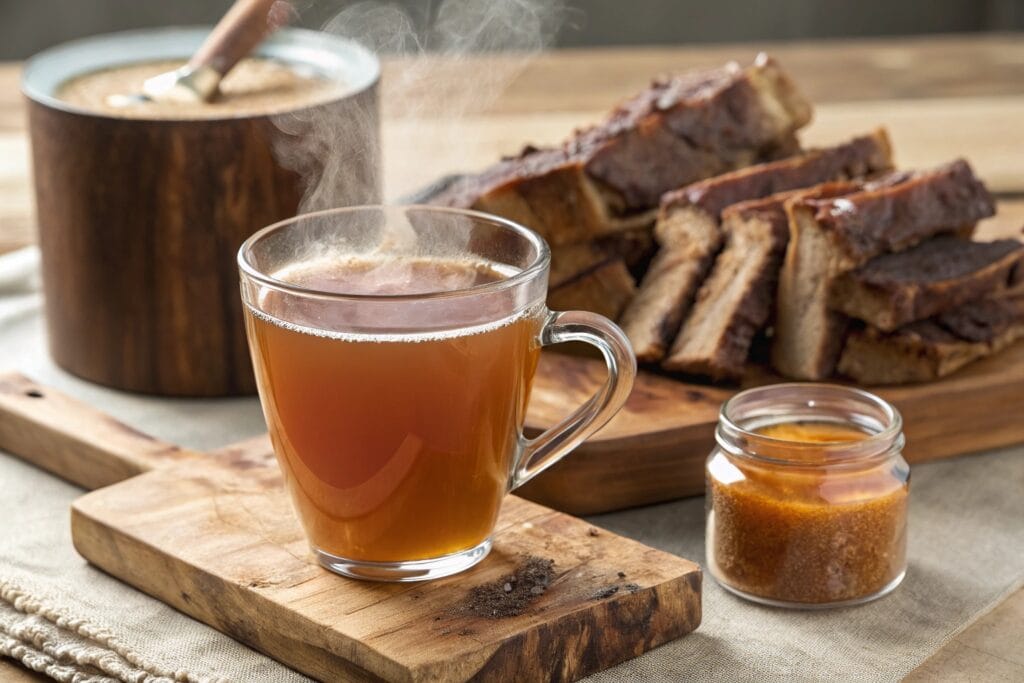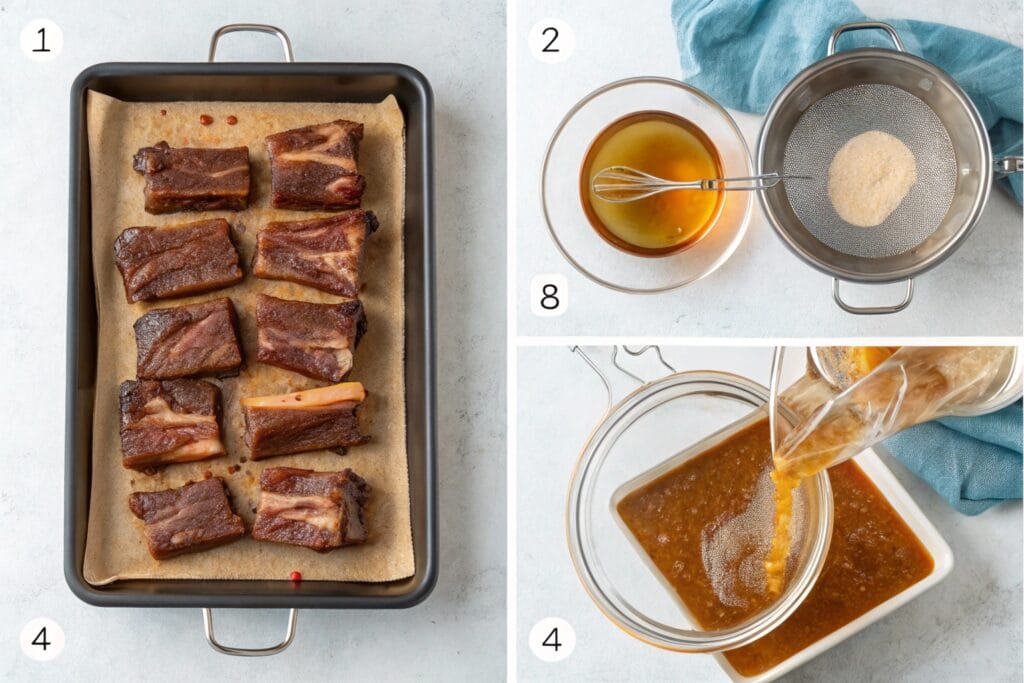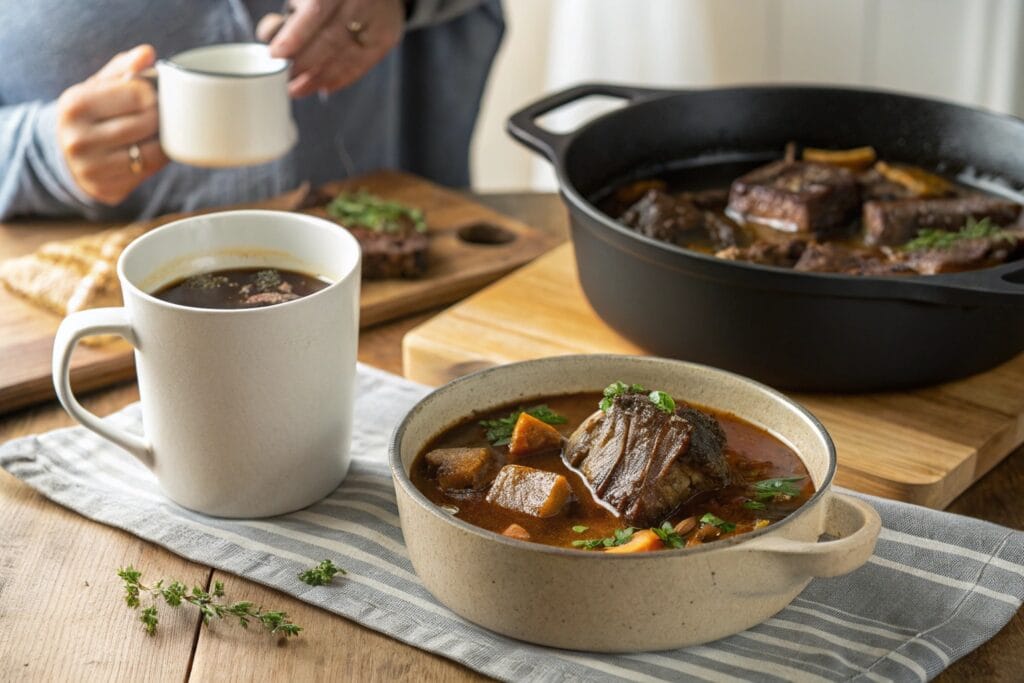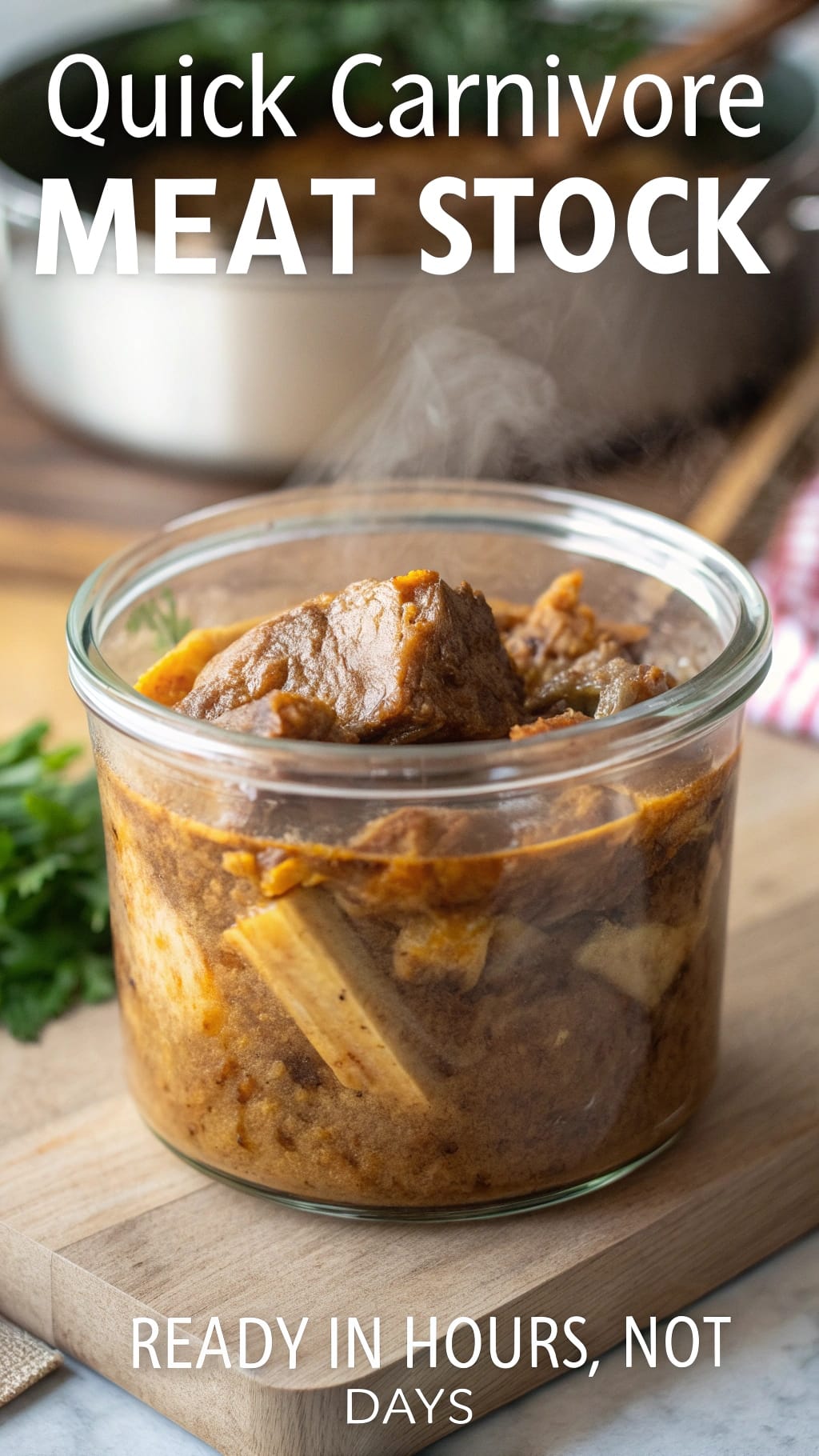Quick Carnivore Meat Stock: Ready in Hours, Not Days
There’s something profoundly nourishing about sipping a mug of homemade beef bone broth. The deep, rich flavor that can only come from slowly simmered grass-fed beef bones delivers not just culinary satisfaction, but a wealth of nutrients that make it a cornerstone of both carnivore and keto lifestyles.
Unlike its lighter cousin chicken broth, beef bone broth offers a more robust, intense flavor profile and higher collagen content. And while store-bought versions might seem convenient, they simply can’t match the nutritional potency and depth of flavor you’ll achieve at home.
In this comprehensive guide, I’ll walk you through creating the perfect beef bone broth—whether you prefer using a slow cooker, Instant Pot, or traditional stovetop method. You’ll discover exactly which bones yield the best results, the crucial roasting step many recipes miss, and how to maximize both nutrition and flavor in every batch.
Table of Contents

Why Beef Bone Broth is a Keto/Carnivore Powerhouse (Benefits)
Before diving into the recipe, let’s understand why beef bone broth deserves a central place in your carnivore or keto regimen:
Collagen Power
Beef bones are particularly rich in Type I and Type III collagen—the most abundant collagen types in our bodies. These structural proteins support:
- Skin elasticity and hydration
- Joint cushioning and mobility
- Connective tissue strength
- Gut lining integrity
The slow-cooking process breaks down this collagen into easy-to-absorb gelatin, providing your body with the building blocks it needs for tissue repair.
Mineral Richness
Quality grass-fed beef bones release essential minerals during the cooking process:
- Calcium for bone health
- Phosphorus for energy production and bone formation
- Magnesium for muscle function and nervous system support
- Potassium for electrolyte balance
- Trace minerals including zinc, manganese, and selenium
The quality of bones matters significantly here—grass-fed and finished beef bones contain superior mineral profiles and better omega fatty acid ratios compared to conventionally raised cattle.
Gut Healing Properties
The gelatin extracted during the cooking process, along with the amino acid glycine, provides exceptional support for digestive health:
- Helps seal and heal the gut lining
- Supports digestive enzyme production
- Reduces inflammation in the digestive tract
- Enhances nutrient absorption
Many carnivore diet followers report improved digestion after incorporating regular bone broth consumption into their routines.
Deep Savory Flavor & Satiety
Beyond nutrition, beef bone broth delivers:
- Intense umami flavor that satisfies cravings
- Natural electrolytes without artificial additives
- A warming, satiating drink that curbs hunger
- A versatile cooking base for carnivore recipes
Learn more about the differences between broths and stocks in our detailed comparison: Bone Broth vs Stock vs Broth: What’s the Difference?
Essential Ingredients for Rich Beef Bone Broth
Beef Bones (The Foundation)
Best Types for Flavor & Collagen (Approximately 3-4 lbs / 1.5-2 kg)
The secret to exceptional broth lies in using a variety of bones:
- Knuckle bones: Rich in collagen and connective tissue
- Marrow bones/femur bones: Contribute fatty richness and marrow nutrients
- Neck bones: Offer meat bits and collagen
- Oxtail: Provides gelatin, marrow, and flavor complexity
- Short rib bones: Add depth and meaty flavor
While any of these will work, a mix creates the most balanced, nutritious broth. If you must choose just one, marrow bones deliver the richest flavor and nutrition profile.
Quality Matters
For optimal nutrition and taste, always opt for grass-fed and grass-finished beef bones. These contain:
- Higher amounts of omega-3 fatty acids
- More conjugated linoleic acid (CLA)
- Better fat-soluble vitamin content (especially vitamin K2)
- Superior mineral composition
- No antibiotic or hormone residues
Your local butcher, farmers market, or online specialty meat suppliers are excellent sources for quality bones. Many grocery store meat departments also stock soup bones, though quality varies.
Water
Use filtered water if possible to avoid any chlorine taste or contaminants affecting your broth. You’ll need enough to cover the bones by 1-2 inches, roughly 3-4 quarts (3-4 liters) for the bone quantity specified.
Salt
Unrefined salt adds trace minerals and enhances flavor:
- Redmond Real Salt
- Celtic sea salt
- Himalayan pink salt
Add salt to taste after cooking rather than at the beginning for better flavor control.
Apple Cider Vinegar (ACV) – Optional Add-in
A traditional addition of 1-2 tablespoons helps extract minerals from the bones. While helpful, it’s entirely optional, especially for strict carnivore diet adherents. If you’re following a pure carnivore diet, simply omit this ingredient—your broth will still be richly nutritious.
The Secret to Deep Flavor: Roasting Your Beef Bones (Highly Recommended Step)
This step differentiates exceptional beef bone broth from merely good versions. Unlike chicken bones, beef bones benefit tremendously from roasting, which:
- Develops complex Maillard reaction compounds
- Eliminates any potential gamey flavors
- Creates a beautiful amber color
- Concentrates flavor compounds
How To Roast Beef Bones:
- Preheat your oven to 400-425°F (200-220°C)
- Arrange bones in a single layer on a rimmed baking sheet or roasting pan
- Roast for 45-60 minutes, turning halfway through if possible
- Look for a deep golden-brown color—this indicates flavor development
- Optional umami boost: In the last 10 minutes, you can brush 1-2 tablespoons of tomato paste onto the bones (note: not strictly carnivore)
Pro tip: After roasting, deglaze the pan with 1/2 cup hot water, scraping up all the browned bits. Add this flavorful liquid to your cooking pot—it contains concentrated flavor compounds you don’t want to waste!

How to Make Beef Bone Broth: Step-by-Step Methods
Method 1: Slow Cooker / Crock Pot (Deep Flavor Development)
The slow cooker method produces exceptional results with minimal effort:
- Place roasted bones in your slow cooker
- Add optional ACV (1-2 tablespoons)
- Cover with filtered water (1-2 inches above bones)
- Set to LOW and cook for 24-72 hours (beef bones benefit from longer cooking times than chicken)
- Check occasionally and add water if needed
- Skim any foam that rises to the top during the first few hours
Why this works: The consistent low temperature maintains a perfect extraction environment for collagen and minerals without vigorous boiling that can cloud your broth.
Method 2: Instant Pot / Pressure Cooker (Faster Option)
When time is limited, pressure cooking offers a viable alternative:
- Place roasted bones in your Instant Pot
- Add optional ACV (1-2 tablespoons)
- Fill with filtered water (respect the MAX line)
- Secure lid and set valve to sealing position
- Cook on HIGH pressure for 3-4+ hours (minimum 180-240 minutes)
- Allow for Natural Pressure Release (NPR)—do not quick release
Important note: While faster, pressure cooking won’t extract quite as much collagen as the slow methods. Consider extending the cooking time to the maximum your model allows for best results.
Method 3: Stovetop (Maximum Control)
The traditional approach requires more attention but allows for perfect customization:
- Place roasted bones in a large stockpot
- Add optional ACV (1-2 tablespoons)
- Cover with filtered water (1-2 inches above bones)
- Bring to a boil, then immediately reduce to the lowest possible simmer
- Maintain a gentle simmer for 12-48+ hours
- Skim foam regularly during the first few hours
- Check water level every few hours, adding more as needed to keep bones covered
Why this works: The stovetop method allows you to visually monitor the extraction process and maintain the perfect simmer—strong enough to extract nutrients but gentle enough to avoid cloudiness.
Final Step: Straining & Storing
Regardless of cooking method, follow these steps to finish your broth:
- Double-strain for clarity:
- First through a colander to remove large bones and solids
- Then through a fine-mesh strainer or cheesecloth for perfect clarity
- Cooling process:
- Divide into smaller containers for faster cooling
- Cool to room temperature (no more than 2 hours)
- Refrigerate promptly
- Defatting & Saving the Tallow!
- After refrigeration, a layer of beef tallow will form on top
- This can be carefully removed and saved for cooking
- Store tallow in a glass container in the refrigerator
- Use it for high-heat cooking and adding richness to carnivore recipes
- Storage options:
- Refrigerator: 5-7 days in sealed containers
- Freezer: 4-6 months in freezer-safe containers
- For convenient use, freeze in ice cube trays or silicone muffin cups, then transfer frozen portions to freezer bags
Pro Tips for the BEST Beef Bone Broth
Achieving a Dark, Firm Gel
The hallmark of exceptional bone broth is its ability to gel when refrigerated. To achieve this:
- Use joint bones with cartilage (knuckles, oxtail)
- Maintain the proper water-to-bone ratio (don’t add too much water)
- Cook for the full recommended time
- Avoid vigorous boiling that can break down gelatin structure
A properly gelled broth indicates high collagen content—the primary nutritional benefit you’re seeking.
Getting Rid of “Funky” Flavor
Sometimes beef bones can impart a slight gamey taste. To eliminate this:
- Blanching option: Before roasting, place raw bones in a pot of cold water, bring to a boil for 10-15 minutes, drain, rinse thoroughly, then proceed with roasting
- Ensure thorough roasting with good browning
- Skim foam diligently during the first few hours of cooking
- Use fresh, high-quality bones
Storing & Using the Precious Tallow
Don’t discard the solidified fat layer! This nutrient-dense tallow is perfect for:
- Cooking eggs, steaks, and ground beef recipes
- Adding to carnivore meals for extra satiety
- Creating rich pan sauces after cooking meats
- Enhancing the flavor of vegetables for keto followers
Re-Using Bones?
While possible to make a second batch with the same bones, the nutrient density and flavor will diminish significantly. If choosing this approach:
- Add 1-2 fresh marrow bones to boost flavor
- Extend cooking time by 25-50%
- Consider adding meat scraps for enhanced flavor
- Use for cooking rather than drinking

How to Use Your Nutrient-Dense Beef Bone Broth
Sipping Plain
The simplest and most direct way to enjoy your broth:
- Warm a mug to your preferred temperature
- Add additional salt to taste
- Consider a pinch of ground black pepper (keto only, not strict carnivore)
- Enjoy between meals or during fasting windows (learn if bone broth breaks a fast)
Base for Rich Keto/Carnivore Soups & Stews
Your homemade broth elevates these dishes to new heights:
- Keto Ground Beef Soup
- Bacon Cheeseburger Soup
- Carnivore Beef Stew (external link)
- Basic meat soups with added salt
Making Rich Pan Sauces or Gravies
After cooking steaks or roasts:
- Deglaze the pan with 1/4-1/2 cup bone broth
- Reduce by half over medium heat
- Whisk in cold butter or saved tallow for body
- Season with salt to taste
Braising Liquid for Tougher Cuts of Meat
Transform economical cuts into tender delicacies:
- Brown meat thoroughly
- Add bone broth to partially cover
- Simmer gently until fork-tender
- Result: Fall-apart meat with concentrated flavor
For more fantastic ways to use beef in your carnivore cooking, check out our Carnivore Ground Beef Recipe collection.
Beef Bone Broth FAQ
Can I use beef soup bones from the grocery store?
Yes, standard grocery store beef soup bones will work, but look for packages containing a variety of bone types rather than just marrow bones. Quality will vary by store—butcher shops and farmers markets typically offer superior options. Whenever possible, ask about the source and whether the bones are from grass-fed animals.
Why is my beef broth cloudy?
Cloudiness typically results from one of these factors:
- Vigorous boiling (maintain a gentle simmer instead)
- Insufficient skimming during initial cooking
- Not straining thoroughly
- Not blanching bones (if they had residual blood or tissue)
While cloudy broth is perfectly safe and nutritious, a clear amber broth generally indicates better technique.
How is this different from the Carnivore Bone Broth recipe?
Our general Carnivore Bone Broth recipe provides a broader approach suitable for multiple bone types. This beef-specific version emphasizes:
- The crucial importance of roasting beef bones
- Longer recommended cooking times for optimal beef bone extraction
- Specific bone selection for beef
- Tallow preservation techniques specific to beef broth
Conclusion
Mastering the art of homemade beef bone broth gives you access to one of the most nutritionally dense foods possible on a carnivore or keto diet. The rich flavor, satiating mouthfeel, and extensive health benefits make it worth the time investment—particularly since most of that time is hands-off.
Whether you’re sipping it as a mineral-rich drink, using it as a cooking medium for other meats, or creating rich sauces, homemade beef bone broth elevates your carnivore and keto lifestyle to new heights of nutrition and culinary satisfaction.
I’d love to hear about your bone broth experiences! Have you tried making beef bone broth before? Which method do you prefer? Share your results or questions in the comments below.
[Recommended external resources: The Weston A. Price Foundation’s guide to bone broth offers additional historical context and nutritional information.]
Enjoy, Review – We Value Your Opinion!
There are no reviews yet. Be the first one to write one.

